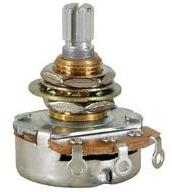What are Audio Taper Potentiometers?

Audio Taper Potentiometers are log taper potentiometers that are specifically designed for use in audio applications.
Audio taper potentiometers are the potentiometers that are used for volume control in audio devices. This includes headphones, headsets, computer speakers, or any volume-altering devices.
The main thing differentiating audio taper potentiometers from others is that audio taper potentiometers are log tapers. Most potentiometers used are linear tapers, meaning any turn in the wiper of the potentiometer changes the resistance linearly. Audio Taper Potentiometers are log tapers, which are potentiometers that change resistance logarithmically as you turn the wiper.
This is crucial for audio applications because logarithmic change in resistance, not linear change, is what is desired. Ours ears perceive sound in a logarithmic fashion. If you were to use a linear potentiometer for volume control, increasing and decreasing sound, the volume changes would not turn out right. A linear taper's adjustment grows far too rapidly as the pot is turned up from zero. This means that the volume levels shoot up too high right when you beginning turning it up. Volume control then is very difficult. For linear tapers, the volume control is squeezed into the first 60 degrees or so of rotation, while the rest of the rotation has little effect of audio. Linear tapers are just not built to manage audio. Log tapers, though, are perfect for audio applications. Its characteristics are suitable to the way our ears receive increasing or decreasing sounds. It gradually increases sound as the wiper is turned.
Thus, audio tapers are potentiometers that are log tapers. This is the key separation from
linear tapers.
Characteristics Curves
The characteristic curves for linear and audio (log) tapers are shown below:

You can see the direct relationship that linear tapers have, while you see the parabolic
relationship that audio (log) tapers have.
